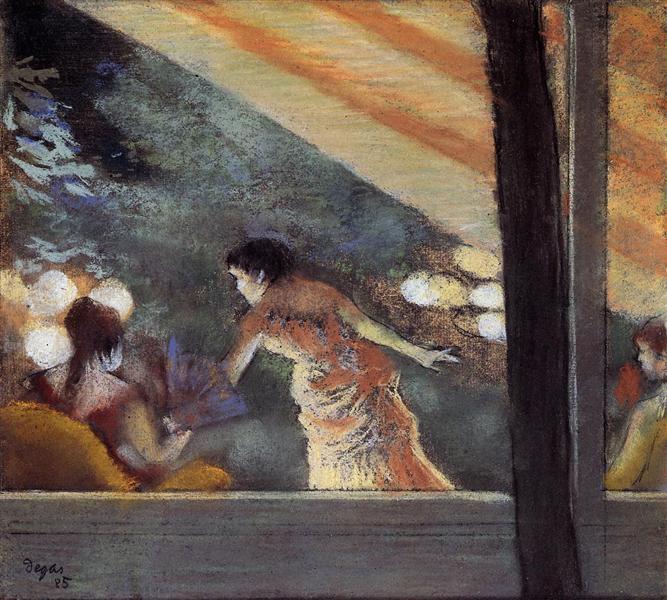विवरण
The work "At the Café Des Ambassadeurs", painted by Edgar Degas in 1885, offers a fascinating insight into Parisian life of his time, perfectly encapsulating the vibrant and effervescent atmosphere of the cafés of the Belle Époque. Degas, known for His ability to capture the essence of movement and the intimacy of the everyday, he uses this painting to explore social interaction and the experience of being present in a community space.
From the first glance, the composition reveals a remarkably dynamic approach. The scene is arranged in such a way as to invite the viewer to become a participant in the café. The way the space is structured, with the central figure of the singer and the spectators scattered about, establishes a visual narrative that goes beyond mere representation. Degas uses an angle that seems to observe the scene from the perspective of an observer sitting at a nearby table, suggesting a sense of immediacy and a palpable connection with the characters depicted.
The colour palette is rich and nuanced, dominated by warm tones that convey a welcoming feeling. The ochres and browns in the café's furniture and decor contrast with the more vibrant touches of the dresses and hats of the women sitting in the foreground, creating a balance that adds to the liveliness of the scene. Degas is noted for his use of colour and light, applying layering techniques that reveal the texture of the fabrics and the atmosphere of the place, transporting the viewer into the warmth and subtle noise of the café.
Among the characters, the figure of the singer takes centre stage, framed by an audience that seems both captivated by her voice and absorbed in its own experience. The expressions and postures of the audience are subtle, but each tells a story. Degas manages to convey a range of emotions, from admiration to indifference, reflecting the complex human relationships that develop in public spaces. The way the bodies are arranged, some leaning forward in a sign of interest and others more distant, suggests a social dance in which each individual has his or her own role to play.
This work is a testament to Degas' interest in capturing the movement and dynamics of modern life. Often linked to Impressionism, although he never considered himself an Impressionist, Degas delves into themes of urban life, exploring interactions in contemporary society through a lens that is both investigative and critical. His technique, which includes the use of pastel and oil paint, allows him to introduce an almost palpable quality to the work, making every fold of fabric and reflection of light seem to come to life.
At the Café Des Ambassadeurs is not only a work of art, but a melting pot of culture and humanity, where the everyday becomes extraordinary. The work invites us to reflect on our own experience of shared spaces, reminding us that life itself, as captured by Degas, is full of fleeting moments that, though ephemeral, resonate deeply through time. Thus, the work stands as a symbol not only of Degas’ artistic innovation, but also of an era that celebrates the vitality of urban life in all its complexities.
KUADROS ©, a famous painting on your wall.
Hand-made oil painting reproductions, with the quality of professional artists and the distinctive seal of KUADROS ©.
Painting reproduction service with satisfaction guarantee. If you are not completely satisfied with the replica of your painting, we will refund 100% of your money.

